Rust And Other Diseases To Be On The Lookout For In Wheat
DR. HEATHER MARIE KELLY
JACKSON, TENN.
As wheat progresses into jointing growth stages, one should be on the lookout for diseases in wheat. In particular, both stripe rust and leaf rust have been reported in Louisiana and Arkansas. Both rusts can survive as dormant infection from the fall that then initiates or continues sporulation when conditions become favorable in the spring. The reports of rusts in Louisiana and Arkansas could indicate a higher risk for rusts in Tennessee this season as most rust spores are blown in from the south (see Figure 1 – Wheat Rust Pathways from http://www.ars.usda.gov/Main/docs.htm?docid=9757 which also contains specific reports on rust in wheat).
Stripe rust (caused by the fungus Puccinia striiformis) has a cooler, optimal temperature range (50 to 64° F) and intermittent rain or dew promotes infection and disease development. Stripe rust is best identified by tiny, yellow to bright orange pustules that form distinct stripes on the leaves (Image 1).
Leaf rust (caused by the fungus Puccinia triticina) has a warmer, optimal temperature range (64 to 77° F) along with high humidity or moisture to promote infection and disease development. Symptoms of leaf rust include small round or oblong raised pustules that are orange red in color. Leaf rust pustules are more scattered and larger in size compared to stripe rust (Image 2).
Significant disease levels and conducive conditions for disease development could warrant a fungicide application prior to flag leaf (Feekes 9 growth stage). Although the decision to apply a fungicide to wheat should be based upon multiple factors including: 1) disease presence, 2) fertility and yield potential, 3) weather conditions and 4) cropping history. A detailed foliar fungicide point system can be found at UTcrops.com (Wheat Foliar Fungicide Point System) that can be used as a guide to determine the need for a fungicide application. See the “Wheat Disease Identification” and “Common Fungal Wheat Diseases” at UTcrops.com for more images and information on additional wheat diseases.
Fungicide applications in wheat are most beneficial after the flag leaf has emerged (Feekes 9 or later growth stage), since the flag leaf can make up approximately 75 percent of the leaf area that contributes to grain fill. Fungicide application can be delayed further if no disease is present and/or there is low disease risk. The next crucial time period for fungicide application is beginning bloom (Feekes 10.5.1) to protect from Fusarium Head Blight (Head Scab). Consult the Fusarium Head Blight Prediction Center at http://www.wheatscab.psu.edu/ for Head Scab forecasts for your area and the “Wheat Fungicide Table” at UTcrops.com for more information on fungicide products and their efficacy against different wheat diseases. Additional information on wheat can be found at UTcrops.com and on the Wheat Quick Facts – http://news.utcrops.com/wp-content/uploads/2015/10/W321_2015.pdf ∆
DR. HEATHER MARIE KELLY: Extension Plant Pathologist, University of Tennessee

Figure 1. Wheat rust pathways in the U.S.

Image 1. Stripe rust

Image 2. Leaf rust image from ars.usda.gov